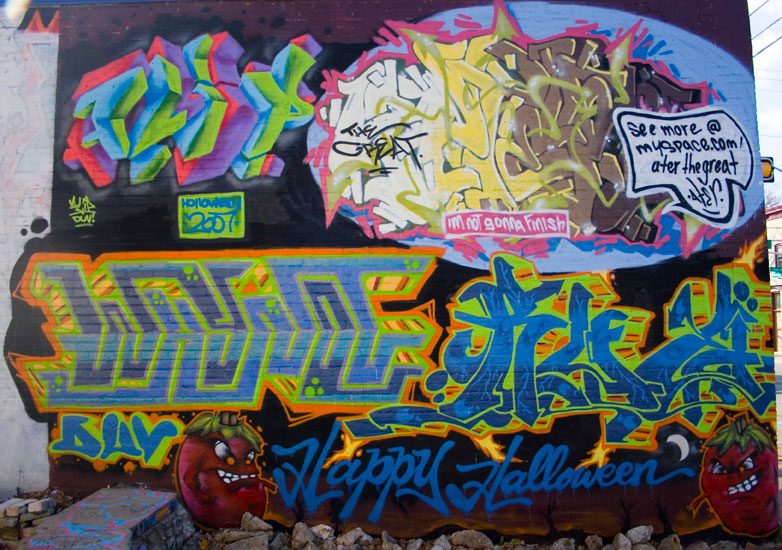 |
|

| Majestic Makeover |
| En Pointe |
| Menace to Masterpiece |
| A Way with Words |
| The Art of Giving |
| Making it Write |
| Tattoo Taboo? |
Menace to Masterpiece: Graffiti Artists Defy Stereotypes |
||||||
| Courtney Davis | ||||||
Even as a 12-year-old, Eliot White saw himself as an artist, and it got him in trouble. Watching a friend of a friend's older brother do a sketch ignited White’s interest in graffiti art and inspired him to learn more. Something about the art form spoke to him as an urban youth, and he wanted to match the artistic skills of his peers, maybe even become better. Soon he was on his way to perfecting his technique everywhere, even drawing on his dresser and spray painting the inside of his closet, much to the displeasure of his mother. As he grew older, his mother wasn’t the only one who disapproved of his means of artistic expression. In fact, it was against the law. The only way for White and other aspiring graffiti artists to practice their skills was by spray painting illegally. Since White’s childhood, however, graffiti art has transformed. Once only found in alleys and under bridges, graffiti now adorns walls of businesses, community centers and private homes and is more culturally accepted worldwide. Free and commissioned spaces in Wisconsin cities now allow graffiti artists to express themselves legally.
“Back then, you had to develop your style either by tagging or with illegal murals, and if you weren’t doing those two, you were just planning your sketch work and not painting at all,” White said. “Now it's different because people like myself are trying to offer alternatives.” White and fellow co-founder Sarah Dollhausen head T.R.U.E. Skool, a Milwaukee-based non-profit organization that supports hip-hop culture and graffiti art as tools to achieve cultural change. T.R.U.E. Skool connects artists who create custom graffiti with interested patrons and holds gallery shows where the public can buy graffiti artwork. White recalled a four-year hiatus where he sacrificed his graffiti art for corporate life. He said he was frustrated that he let go of his talent, but the break allowed him to redefine himself as an artist. Now, White has found a way to use his art to pay the bills and has done graffiti design work creating murals for large companies such as Harley Davidson and U.S. Cellular. “It’s no different from a computer person or a guy who loves business or a doctor who loves being a doctor,” White said. “We love to be graffiti artists, and there are opportunities for us to get paid.” “Graffiti art has definitely become much more accepted,” Dollhausen said. “It's gone from young people on the street stealing spray paint to people paying thousands of dollars to commission artists to do murals.” Dollhausen said misperceptions about graffiti often stem from officials using the term when referring to criminal activity and a lack of education in general about the art form. According to White, Milwaukee’s war against graffiti only makes things worse. He said that publicizing graffiti on the news aggravates and encourages other youth to engage in vandalism. “Instead of setting up programs, it’s like they’re just trying to stomp out roaches,” White said. “They stomp the ones they see, and what they don’t realize is that others are popping up, you just can’t see them.” In addition, White said the penalties for graffiti are too severe. Youth accused of vandalism can be charged with a felony, the same harshness used against criminals who rape and murder. “Sex predators get counseling; drunken drivers get counseling. [These kids] may not need counseling, but what they do need is an outlet,” White said. |
||||||
1 | 2 | 3 print this article |
||||||
About Us | Contact Us | Business Partners | Archives | Sitemap
Copyright 2007 Curb Magazine
